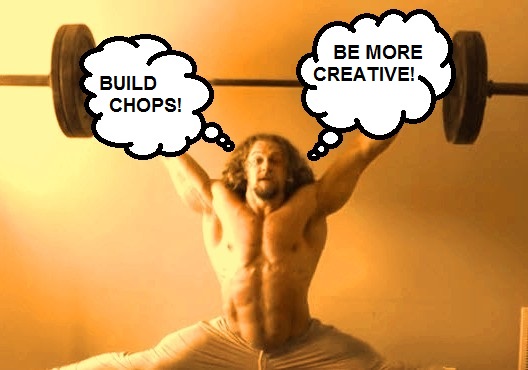Is your first thought when you wake up, “Where’s my horn?…I can’t wait to practice!”
Commuting home from work, are you reaching for the recliner and the remote,…or do you make a beeline for the practice room?
 Far too many students tell me, “Practice is drudgery!”
Far too many students tell me, “Practice is drudgery!”
SOLUTION?
Redesign your practice routine, so it’s not routine.
To be both effective and intriguing, your practice must do two things:
-
build chops. and
-
engage your imagination.
If you just “play for fun,” you’ll sound the same in 20 years as you do now, get bored, disillusioned, and quit.
On the other hand, If your study consists only of dry, lifeless exercises, your creative juices will lie dormant, your imagination will not be stirred, and your practice time will feel stale, uninviting.
If you practice joy, your performance will exude joy, and your audience will experience joy.
For example, yesterday, i picked up my horn and just started playing random notes, digging the sound, experiencing the feeling, searching for a fascinating, original idea. After a few minutes, i hit on this phrase:

That felt interesting enough to be worth cycling through all 12 keys, so i did.
While playing through all 12 keys, you discover technical challenges in some keys not found in others. This especially occurs when you move into the extreme high or low end of your range. Here is where that lick got tough for me on tenor:

Band in a Box can both slow down and loop a passage such as this, which helps you to focus in on trouble spots which need more attention.
Two things happened while i shed this lick:
- I felt joyful, because i was exploring uncharted waters, discovering new melody, creating something personal and unique.
- At the very same time, my chops were getting stronger, and my confidence was growing.
[As an aside, your level of confidence must always equal your level of ability. If not, you will be either unattractively timid or unbearably arrogant.]
OK, so now you’ve discovered this cool lick and worked it out in all 12 keys. But you can’t keep playing that same lick forever, or it gets stale.
I’ve got a notebook with hundreds of these licks i’ve discovered over the years. But i never play them on the gig. That’s not the point! I’m simply limbering up my fingers, warming up my creative imagination, and developing an improvisatory vocabulary.
So where do we go from here?
After about 20 minutes and a lot of experimentation, that original lick morphed into something sounding like this: 
So what cool licks has your practice time turned up lately? Care to share them with the rest of us? I’d love to hear your ideas. Post them here. Better yet, join us at https://dcmworkshop.com/ , where you can hang with some cool colleagues, and trade licks with a dozen world-class master teachers.
If you need to jump start your ear training / improv chops, download “New Ears Resolution,” as students the world over have been doing for the past decade.
The recordings you hear here (4 clarinets) were performed by me without any printed music. However, if you need a FREE chart to help you play along, fill out the form below, and i will be delighted to email you the pdf of these 2 licks in all 12 keys.

I think the one thing that motivates me to practice is listening and hearing great musicians. It’s like, “Wow, that was sooo cool. I want to play like that!” Another cool part about living in an age of wonderful technology is that it has revolutionized music education and how we can practice. Making use of these tools can not only take away the “drudgery” but in fact make it flat out cool and fun! Combine this with good practice habits, and you have a winning combination that will allow for much reward and success.
LikeLike
So that means if “auto-shuffle: jazz” is cranked up while i play Go, it’s kind of like practicing?
LikeLike